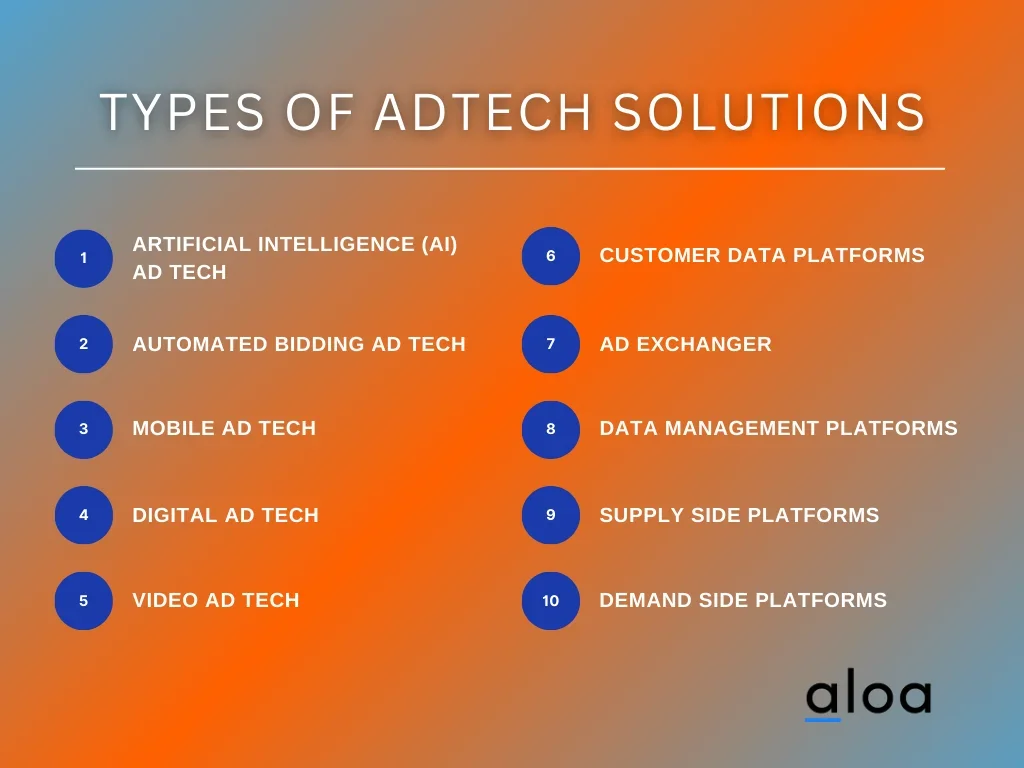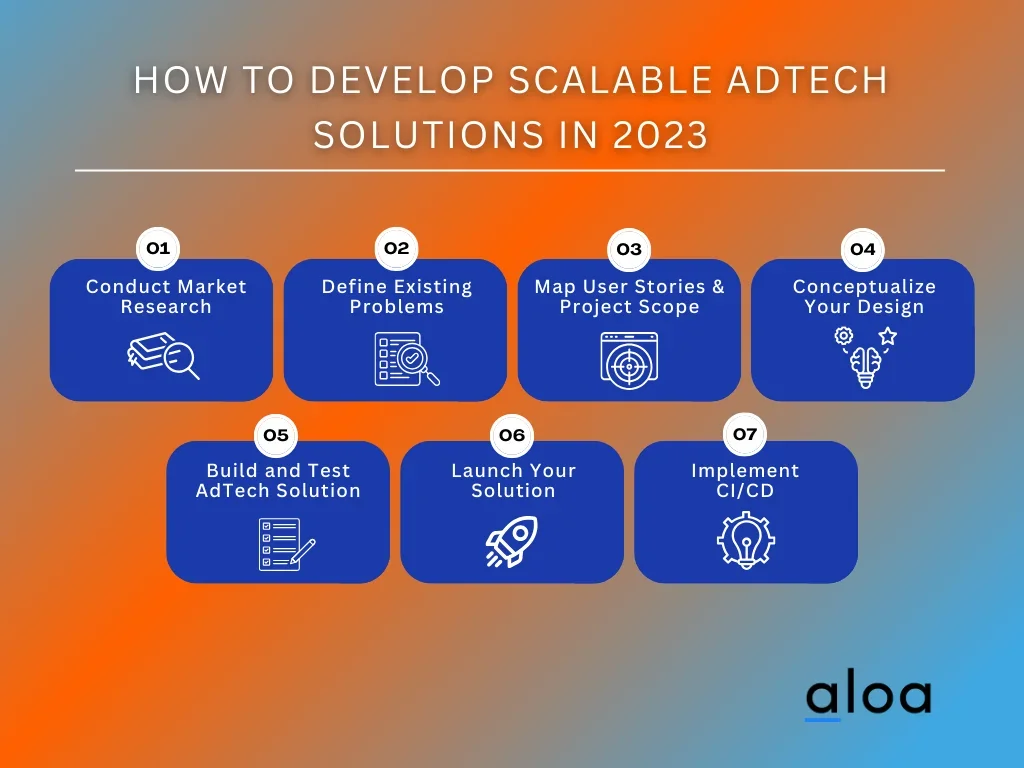Adtech solutions have greatly improved the potential and scalability of modern marketing agencies and businesses to meet the constantly changing demands of their target markets. In effect, it has become easier to reel in and engage top-quality leads and continue to drive growth.
Incorporating tech has made it possible to track customer behavior and target ads more effectively, giving marketers unprecedented power to connect with their audiences and drive engagement.
To help you start that process, our team at Aloa presents this guide to adtech solutions: their importance, types, and benefits in 2024. We'll draw from our own experiences and processes within the software development field that bring in quality leads that leverage our goals as a company in a highly competitive digital landscape.
Afterward, you'll know how to create a scalable and effective adtech strategy that drives profits and grows customer loyalty.
Let's get started!
What is AdTech?
AdTech stands for Advertising Technology and refers to software and processes that optimize and streamline digital marketing efforts. Adtech solutions include all the components involved in delivering digital marketing advertisements from start to finish, such as tracking mechanisms, delivery/placement methods, mobile ads, or search engine ads.
The primary use of adtech for startups, businesses, and advertisers is tracking customer behavior and targeting ads more effectively according to customer profiles. Using these types of technology solutions to measure the effectiveness of campaigns potentially leads to improved ROI.
Different Types Of AdTech Solutions
Since the digital advertising industry is not limited to one type of solution, companies have a wide range of options. Each solution targets a specific marketing challenge, and each offers its own set of benefits. As you start to explore which type of adtech solution best fits your needs, consider the types below:

Artificial Intelligence (AI) AdTech
AI adtech enables users to analyze customer data and create campaigns tailored to each customer's specific needs with product or service offerings. Since AI algorithms can predict which ads prove most effective, using AI tech can help you reach the right audience with more precision.
Automated Bidding AdTech
Automated bidding solutions allow users to bid on ad space in real time. Accessing real-time updates on ad space bidding will enable marketers to make quick and strategic decisions that can ultimately determine the success of a campaign. Additionally, using automated bidding adtech eliminates the need to conduct manual bidding processes, improving campaigns' speed and accuracy.
Mobile AdTech
With mobile adtech solutions, marketers can effectively implement the mobile-first approach that has dominated the digital realm for the past few years. Leveraging mobile adtech makes it easier to target mobile users and track their behavior on their chosen devices.
Mobile adtech is particularly useful for applications that rely heavily on customer engagement and retention since these solutions allow advertisers to create personalized experiences tailored to each user.
Digital AdTech
Advertisers looking to improve their efforts in optimizing digital ads and targeting them to a specific audience benefit greatly from exploring the capabilities of digital adtech. Digital adtech can help you create targeted campaigns more quickly and accurately, essential for running effective digital marketing strategies.
Video AdTech
Video adtech solutions allow marketers to craft and deliver personalized ads on video streaming services like YouTube. Since video has become an effective way to engage a specific audience, these solutions make it easier to target viewers and create unique experiences for each potential customer.
Customer Data Platforms
Since adtech is all about understanding market and consumer behavior, using customer data platforms (CDP) enables users to analyze and aggregate information on customer behavior, preferences, and needs more precisely, informing the types of campaigns you create.
Supply-side Platforms
Supply-side platforms are essential for publishers and app developers in the adtech ecosystem. These platforms help optimize and automate the selling of digital ad inventory, making it easier for publishers to monetize their content. By integrating with demand-side platforms, supply-side platforms enable publishers to efficiently connect with advertisers and deliver targeted ads to their audiences.
Demand-side Platforms
With demand-side platform marketing technology, advertisers have the power to reach their target audience across various channels and devices. These platforms offer sophisticated targeting capabilities, allowing advertisers to optimize their campaigns based on demographics, interests, and browsing behavior. By using demand-side platforms, advertisers can effectively manage their ad budgets and allocate resources to the channels that deliver the best results.
How To Develop Scalable AdTech Solutions in 2024
As you develop your adtech solution, understanding the general process streamlines your efforts. It makes sure the final outcome performs as you expected.
While there are multiple ways to approach tech development, a process-oriented approach will enable companies to gain a competitive edge in the ever-shifting landscape of digital advertising.
Startups and businesses looking to develop this type of solution do well to consider the steps listed below in determining the type of adtech to use and the strategy to implement:

Step 1: Conduct Market Research
Successful ad campaigns rely heavily on strategic market research into customer demographics, preferences, and behaviors. This initial research should provide the insights needed to determine the type of adtech solution that best meets your needs in 2024.
As you conduct your market research, you must uncover how customers interact with your brand. Understanding the different types of customer profiles and their desired experiences will help you create campaigns that attract and engage them effectively.
Throughout the research process, you'll ideally compile details on the following points:
- Customer preferences and behaviors
- How customers interact with your brand
- Different customer profiles
- The type of campaigns that attract the most engagement and ROI
- Types of digital channels that generate the most leads
Step 2: Identify Your Goals
Based on the market research results you've compiled in step one, you'll use that information to identify the goals of your ideal adtech solution. As outlined in the previous section, each adtech solution offers its own unique set of benefits. Hence, it's essential to determine those to make the most effective decision.
Your goals should include both short-term and long-term objectives. For example, you might want to increase brand awareness or drive customer acquisition within a specific timeframe. Knowing these goals will help you choose the right adtech solution based on your objectives.
In some cases, two or more types may meet your requirements. In such cases, it's essential to weigh the importance of each element and base your final decision on which offers the most benefits for your business.
Step 3: Outline Your User Story Map and Project Scope
After identifying your goals, the next step is to outline your user story map and project scope. A user story map visually represents user goals and their relationship to each other. It also helps you plan how the product should work. Creating a user story map makes it easier for you to align your goals with those of your customers and potential leads.
Your project scope outlines what tasks are needed to complete the project, including the timeline for each task. By outlining both of these key elements, you will better understand your resource needs and be able to plan more effectively.
Your user story map and project scope will provide a clear roadmap for developing an effective adtech solution that meets your needs in 2024.
Step 4: Conceptualize Your Design
Now that you have defined the basic details of what you want your ideal adtech solution to accomplish, you can start conceptualizing your design. During this stage, you should focus on how you want the user experience of your adtech solution to be.
Your conceptualization should also include elements such as the look and feel, the interactions users will have with the product, and how it can help them achieve their goals. This is also an excellent time to start sketching out what type of visuals will work best for your user experience.
Taking the time to plan out the concept and design of your chosen adtech solution ensures that the final outcome has a high ROI potential while still having the scalability to meet increasing demands.
Step 5: Develop and Test Your AdTech Solution
With your concept and design drafted out, you can start formally developing your adtech solution. Here, you'll begin to explore potential partners to work with or professionals to hire to work on your adtech development project.
Remember that developing adtech solutions requires a team of experts with experience in various disciplines such as data science, marketing automation, web design, and development. With that, vet your developers thoroughly to ensure they are experienced in the adtech you want to create.
Once you develop your solution, you must test it against key performance indicators (KPIs) such as click-through rates (CTR), conversions, and user engagement. This will allow you to refine the process and ensure the product can achieve its intended goals.
Step 6: Launch Your Solution
Launching your adtech solution requires a comprehensive strategy outlining how to market and promote it. This should include a plan for user acquisition, content marketing, and outreach activities.
Additionally, remember to set up analytics tools such as Google Analytics or Adobe Analytics to track the performance of your adtech solution in real time. These essential tools provide excellent support to understand the impact of your adtech solution on user engagement and ROI.
Step 7: Apply Continuous Integration and Continuous Deployment (CI/CD)
Even if you've formally integrated and applied your adtech solution to daily workflows and processes, it's essential to incorporate CI/CD into your strategy. CI/CD is an automated process that allows you to quickly and easily deploy new features and updates to your adtech solution without manually coding it every time changes are made.
A CI/CD process ensures that the product remains up-to-date with the latest trends, technologies, and customer needs. This helps ensure that your adtech solution remains effective and fruitful in the long run.
Finally, ongoing monitoring and optimization is one of the most essential steps to maintain an effective adtech solution. This means regularly tracking user engagement metrics for each campaign's impressions, clicks, conversions, and ROI.
Business Benefits of Leveraging AdTech Solutions
Incorporating adtech solutions into your marketing campaigns can help you realize several benefits. These benefits go past the capabilities of traditional marketing campaigns and include:

Realize Higher ROI
With the right adtech technology to enhance your marketing operations, you'll have the potential to reel in not just leads but highly qualified leads who are more likely to convert into loyal clients or customers. Additionally, adtech solutions make it easier to make strategic decisions that can help you save time and money on marketing efforts, ultimately realizing a higher ROI while still following a cost-effective process.
Improved Customer Experiences
Since adtech solutions focus on analyzing and curating market trends and user behaviors, you can use this data to create tailor-made customer experiences. This will help them find the product or service they're looking for quickly and efficiently and keep them informed on any changes or updates related to their purchase. In turn, you'll see improved customer experiences as those who engage with your marketing campaigns will likely become repeat customers.
Leveraged Automated Workflows and Scalability
In today's fast-paced business environments, workflow automation and scalability are essential for staying competitive in developing the right content for digital campaigns. Adtech solutions make it easy to take advantage of both these features, as they can help you automate mundane tasks and quickly scale up your operations based on customer demand or market conditions.
Precise Demographic Targeting
Using demographic targeting to your advantage allows you to stay ahead of the competition and focus your marketing efforts on a specific audience. With adtech solutions, you get the precise targeting to reach the right people at the right time and with the right message. This helps ensure that all your campaigns have higher ROI potential since they're directed towards customers most likely to convert.
Enhanced Campaign Speed for Advertisers
As part of the efforts of businesses to stay top of mind to their target markets and have a competitive edge, there's an increasing demand for faster turnarounds in campaigns. Leveraging adtech solutions can help you speed up the process of marketing campaign development and execution while also allowing you to adjust quickly to changing market conditions or customer needs.
The importance of adtech solutions for online advertising on the internet will only increase as technology advances and businesses continue to focus on leveraging data-driven insights to stay competitive.
Leveraging adtech solutions will give you the tools and resources necessary to create powerful campaigns that generate real results while gaining a better understanding of customer preferences. Ultimately, taking the time to understand the importance, types, and benefits of advertising campaigns and their solutions can help you take your business strategies to the next level in 2024
Key Takeaway
Adtech solutions in 2024 are becoming increasingly important due to their ability to provide businesses with the tools and resources necessary to create powerful campaigns that generate real results. They also offer advanced capabilities such as automation, web design and development, demographic targeting, and enhanced campaign speed—all of which can help you stay ahead of the competition in an ever-changing digital landscape.
Startups do well to get ahead of the game by applying this new type of technology to their marketing campaigns to amplify their efforts and gain a competitive edge. With the right adtech solution, businesses can enjoy higher ROI, improved customer experiences, leveraged automation, and scalability, precise demographic targeting, and enhanced campaign speed.
Adtech isn't just for big companies anymore. Startups have joined the game, too. If you're a startup wanting to take advantage of adtech, reach out to our team at [email protected] where our Account Executives can help you plan an effective strategy for leveraging them into your operations. With the right technology and processes, you can take your business strategies to the next level in 2024.

